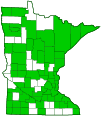crab spiders
(Mecaphesa spp.)
Overview • Description • Distribution • Taxonomy
Description |
Mecaphesa are small to medium sized crab spiders. The upper side of the front part of the body (carapace) is covered with erect hairs (setae). All of the eyes are on low raised projections (tubercles). In the front row the outermost eyes, the anterior lateral eyes (ALE), are a little larger than the innermost eyes, the anterior median eyes (AME). In the back row the posterior lateral eyes (PLE) are directed sideways and backwards and are on the same tubercle as the ALE. They are not visible when the spider is viewed from the front. On the female, there are no dark longitudinal stripes on the carapace. The pattern on the abdomen is obscure. The legs do not have dark bands. The first and second pairs of legs have 3 to 8 spines on the underside of the fifth and sixth leg segments (tibia and metatarsus respectively). On the male the carapace has two dark longitudinal stripes. The pattern on the abdomen is distinct. The legs have dark bands on the third segment (femur), tibia, and metatarsus, but not on the last segment (tarsus). The number of spines on the legs is reduced. |
Distribution |
||
|
Sources |
|
| 7/26/2024 | ||
Taxonomy |
|
Class |
Arachnida (arachnids) |
Order |
|
Suborder |
Araneomorphae (typical spiders) |
Infraorder |
Entelegynae |
Superfamily |
Thomisoidea (crab and running crab spiders) |
Family |
Thomisidae (crab spiders) |
Subfamily |
Thomisinae |
Tribe |
Misumenini |
Until recently, almost all species currently in the genus Mecaphesa were placed in the genus Misumenops. In 2008 almost all of the North American Misumenops species were transferred to Mecaphesa. |
|
Subordinate Taxa |
|
northeastern flower crab spider (Mecaphesa carletonica) northern crab spider (Mecaphesa asperata) swift crab spider (Mecaphesa celer) western flower crab spider (Mecaphesa sierrensis) |
|
Synonyms |
|
|
|
Common Names |
|
This genus has no common name. The common name of the family Thomisidae is crab spiders, and it is used here for convenience. |
|
Glossary
Carapace
The hard, upper (dorsal), shell-like covering (exoskeleton) of the body or at least the thorax of many arthropods and of turtles and tortoises. On crustaceans, it covers the cephalothorax. On spiders, the top of the cephalothorax made from a series of fused sclerites.
Femur
On insects and arachnids, the third, largest, most robust segment of the leg, coming immediately before the tibia. On humans, the thigh bone.
Metatarsus
The sixth segment of a spider leg.
Seta
A stiff, hair-like process on the outer surface of an organism. In Lepidoptera: A usually rigid bristle- or hair-like outgrowth used to sense touch. In mosses: The stalk supporting a spore-bearing capsule and supplying it with nutrients. Plural: setae.
Tarsus
On insects, the last two to five subdivisions of the leg, attached to the tibia; the foot. On spiders, the last segment of the leg. Plural: tarsi.
Tibia
The fourth segment of an insect leg, after the femur and before the tarsus (foot). The fifth segment of a spider leg or palp. Plural: tibiae.
Visitor Photos |
||
Share your photo of this arachnid. |
||
This button not working for you? |
||
Mike Poeppe |
||
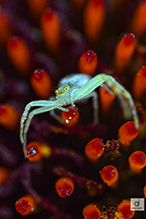 |
|
|
Babette Kis |
||
Mecaphesa crab spider Mecaphesa are some of my favorite critters to photograph, and this 6mm raspberry pink one caught my attention a few days ago. Mecaphesa sp., crab spider, on goldenrod sp. Photographed at Barnes Prairie, Racine Co., WI October 6, 2022. |
||
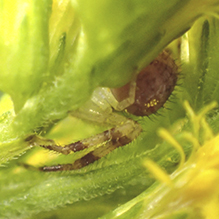 |
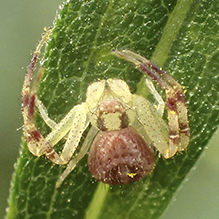 |
|
The photo of the crab spider hiding among flowers, waiting for prey, was taken first. |
While I was trying to move the flower in front of the spider to get a better picture, it jumped onto the leaf below, enabling me to get the second picture. |
|
Mecaphesa with ant prey |
||
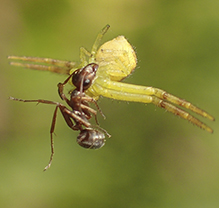 |
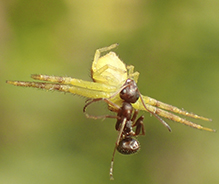 |
|
It was very windy, and the spider stretched its legs out to be parallel to the direction of the wind. |
||
This spider had jumped off of the goldenrod. Not sure if it caught the ant before it jumped, or as it jumped. |
||
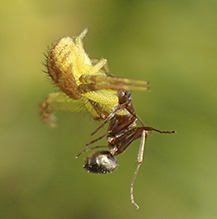 |
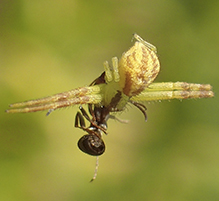 |
|
… then stretched them out to be parallel to the wind, so that the least amount of surface area was exposed to the wind. |
||
When it began to spin, it brought its legs into its body,… |
||
Alfredo Colon |
||
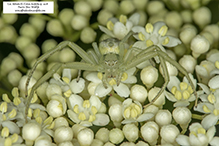 |
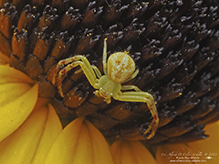 |
|
MinnesotaSeasons.com Photos |
||
|
||
|
||

Slideshows |
|

Visitor Videos |
||
Share your video of this arachnid. |
||
This button not working for you? |
||
|
Other Videos |
||
Mecaphesa Moving Eyes |
About
May 24, 2013 Jumping spiders and crab spiders are among the few spiders that can move their "main" eyes. The main eyes of an eight-eyed spider are the anterior middle two eyes. Here you see the main eyes of an adult male Mecaphesa celer moving. Spiders don't have ball-and-socket eyes like we do. Instead they just move their retinas. Crab spiders make images with these moving eyes, but the images are in focus only at about a centimeter. Most Mecaphesa celer are pale yellow or tan in color. The green abdomen makes this one unusual. Some young (elementary school) arachnologists found this spider in a patch of ragweed during a program I was conducting in Austin, Texas, on May 23, 2013. It has a body length of 3mm, or just under 1/8 inch. |

Visitor Sightings |
||
Report a sighting of this arachnid. |
||
This button not working for you? |
||
Mike Poeppe |
Location: Houston, MN |
 |
| Babette Kis 10/6/2022 |
Location: Barnes Prairie, Racine Co., WI Mecaphesa are some of my favorite critters to photograph, and this 6mm raspberry pink one caught my attention a few days ago. Mecaphesa sp., crab spider, on goldenrod sp. Photographed at Barnes Prairie, Racine Co., WI October 6, 2022. The photo of the crab spider hiding among flowers, waiting for prey, was taken first. While I was trying to move the flower in front of the spider to get a better picture, it jumped onto the leaf below, enabling me to get the second picture. |
 |
| Babette Kis 9/10/2022 |
Location: Barnes Prairie, Racine Co., WI This spider had jumped off of the goldenrod. Not sure if it caught the ant before it jumped, or as it jumped. It was very windy, and the spider stretched its legs out to be parallel to the direction of the wind. When it began to spin, it brought its legs into its body, then stretched them out to be parallel to the wind, so that the least amount of surface area was exposed to the wind. |
 |
| Alfredo Colon 8/21/2022 |
Location: Albany, NY |
 |
| Alfredo Colon 8/12/2018 |
Location: Woodbury, Minnesota |
 |
MinnesotaSeasons.com Sightings |
||
|

Created: 4/18/2019 Last Updated: © MinnesotaSeasons.com. All rights reserved. |
